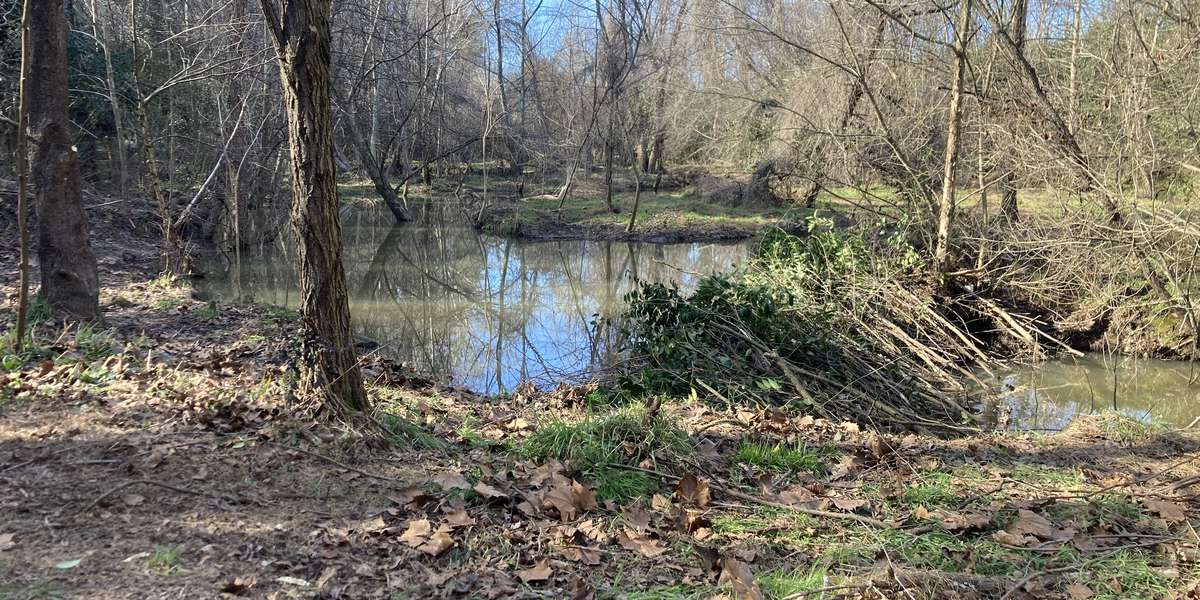2023
2024
2025
February 4, 2023 at 2:33 PM

Rocky Branch Greenway Beaver Dam
Managed by North Carolina State University
Since 2023
In North Carolina, US
MEA101
This chronolog combines 723 photos from 157 contributors. Learn more
About this site
In October 2022, one or more North American beavers (Castor canadensis) migrated up Rocky Branch from Walnut Creek. They established a dam across the creek at the site of an earlier stream restoration project.
Rocky Branch is a first-order headwater stream of the Neuse River basin. The 3.0 square kilometer basin above the beaver dam drains much of the main campus of NC State University between Hillsborough Street and Western Boulevard. The catchment responds quickly to precipitation events because of its small size and the high percentage of impervious surfaces (e.g., roads, parking lots, and buildings) across the NC State campus. As a result, the stream's discharge quickly increases when it rains. Heavy rain events often partially breach the beaver dam, decreasing the upstream pond level. After such events, the mostly nocturnal activities of the beaver(s) are readily apparent the following day as they work to repair the dam.
However, on February 4, 2024, exactly one year after the establishment of this Chronology station, faculty and students from the Department of Biological and Agricultural Engineering installed a pond-leveling device called a “beaver deceiver.” The pond leveler limits the water surface height of the pond to protect prior stream restoration efforts from beaver-enhanced flooding. The pond leveler was damaged by a flooding event on the evening of June 30, 2024, and ceased to function. It was subsequently removed from the stream around July 24, 2024.
May 26, 2025, is the last date to show evidence of dam construction efforts by the local beavers. We will continue to monitor the site through the fall semester to see if the beavers return and attempt to dam Rocky Branch at this location again.
The U.S. Geological Survey has a real-time stream monitoring station about 200 feet downstream from the Beaver Dam that records stream stage, discharge, and precipitation. It is available here.
In addition, the U.S. Geological Survey also maintains two real-time groundwater monitoring wells about 200 feet upstream from the beaver dam, adjacent to the Greenway Path. The depth from the ground surface to the water table is available at the regolith well #1 and bedrock well #2. Water levels in the wells track precipitation, stream discharge, and beaver activities. When the beavers increase the height of their dam on Rocky Branch, the water levels in the wells also increase. The well water levels fall when the beaver dam is diminished in stature following a flood event.
Faculty and students in NC State University’s Department of Marine, Earth, and Atmospheric Sciences maintain this Chronolog Station. We are studying beavers in urban streams around the greater Raleigh area. We are interested in the physical and biological changes in urban streams following the establishment of beaver dams and their potential to improve the physical, hydrologic, and biological function of human-modified and impaired streams.
We have set up a sister iNaturalist project to collect observations on the flora and fauna associated with the NC State campus beaver pond reach of Rocky Branch. If you are an iNaturalist user, help us out by joining the project and recording your observations for the NC State Campus Beaver Pond project .
Thank you for reading about this Chronolog site and contributing your photographic observations. We encourage repeat visits to see how this reach of Rocky Branch changes after rain events and with the seasons.
Please get in touch with Karl Wegmann, Associate Professor of Geology and Geomorphology at NC State University, at kwwegman@ncsu.edu with questions or comments.
About North Carolina State University
Dept. of Marine, Earth, and Atmospheric Sciences at NC State.
For nature-lovers
Explore chronologs
For organizations
Chronolog is a monitoring tool for parks, nature centers, wildlife organizations, schools, and museums worldwide. With over 100,000 contributors across 300 organizations, Chronolog is on a mission to engage communities with nature while recording important natural changes.
© Chronolog 2025 | Terms